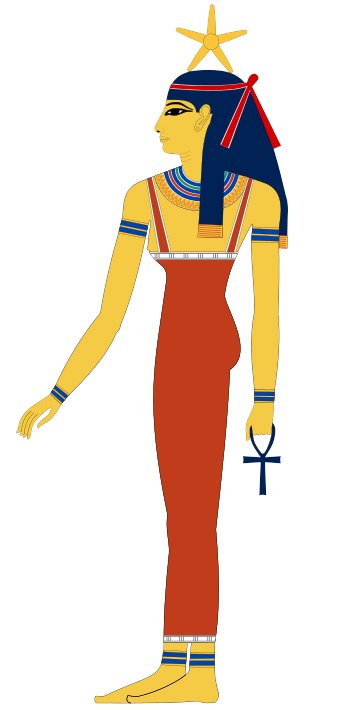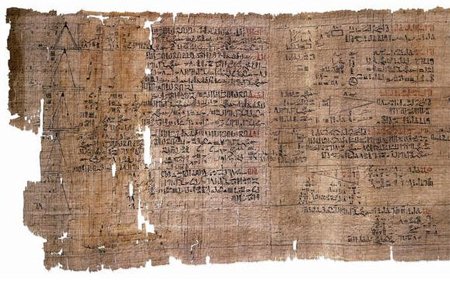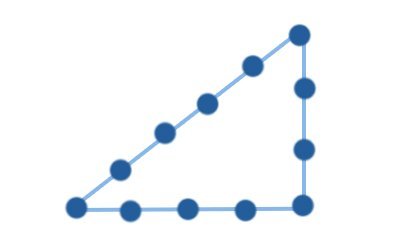EGYPTOLOGY: Science in Ancient Egypt
My dear readers, today I wanna re-start my blogging activities here on steemit after a quite long period of absence for which I truly apologize. But now I am back with a fresh subject that might be as fascinating to you as it is to me: Science in Ancient Egypt. You will be probably surprised of what I summarize under "science", but after reading maybe you agree with me – innovation and technology is something that is accompanying us since millennia and it won't stop in future. ;)
In this article I wanna cover two areas of science that played an important role in Ancient Egypt:
• Astronomy and time-keeping (calendars)
• Mathemathics and Metrology
Astronomy

Sirius and Orion, Image by NASA, Public Domain
When we think in today's terms of astronomy we see telescopes and satellites scanning the sky to find answers to scientific questions regarding the source of our universe. The Ancient Egyptians didn't have this kind of advanced tools but they had their eyes, their mind and a lot of time to observe. This is one of the keys to understanding "science" in antiquities time: In the beginning, there is always a question or a problem to solve. And the people of Egypt millennia ago had a lot of them...
Sun, moon, stars
 Goddess Sopdet, source
Goddess Sopdet, source
The sky led the people through time and space. In a landscape that mainly consisted of desert areas a clear orientation was not only important but could decide over life and death in critical situations. Therefore the stars were used to accompany the Ancient Egyptians on their way through the sands. They already knew the difference between moving stars and so-called circumpolar stars that never went below the horizon due to their special orbit in relation to the earth. They were called the "Imperishable Ones" (Rossi 2010: 394).
The very bright star Sirius that belongs to the ones that rise and set was one of the most important sky objects. In Egyptian hieroglyphic writing, its name was "Sopdet" and had its religious and mythological expression in the same named Goddess Sopdet. The Greeks called the star Sothis. Together with the moon, they were used for time-keeping systems (Rossi 2010: 395) that I will explain in the following paragraph.
Calendars
 Hieroglyphic Calendar in Kom Ombo Temple, source
Hieroglyphic Calendar in Kom Ombo Temple, source
The Ancient Egyptians firstly developed a lunar calendar that based on either 29 or 30 days. But the lunar (with the moon cycle connected) month has 29,5 days. Thes led to (cyclic repeating) irregularities in the calendar. So they switched to a solar (sun based) time-system that lasted for thousands of years, while the lunar calendar still persisted a long time for religious ceremonies and festivals. The solar year started with the first rise of the star Sirius, as mentioned above. From this time on, they counted 12 months of 30 days, that made 360 days. As we know today a "normal" year has 365 days. The Ancient Egyptians were aware of this and simply added 5 more days to the solar year. With developing more precise observing and calculation tools we know today that a solar year lasts a few hours longer than 365 days – this was something the Egyptians did not consider for thousands of years. This relatively small irregularity led to the fact, that the full cycle of the calendar needed 1460 years to complete.
Orientation of Monuments
The equinoxes, the equation of day and night that occurs two times a (solar) year and is still celebrated today by many people at June 21st and December 21st, was also very well known to the Ancient Egyptians. In some monuments, we can see for a small period of time that the beams of the sun are pointing to a special area in a temple or funerary complex. The Temple of Karnak is one example where even today hundreds of people gather together to embrace the light. Another example is the Tempel of Abu Simbel near Assuan in the south of Egypt, where the sun is shedding its light to the holiest part of the complex: the sanctuary inside.
Found this amazing footage on Youtube, where you can clearly see the sunbeams coming through the Karnak temple.
Another possible alignment with the stars could be the orientations of the Pyramids of Giza in Cairo. It is very controversial discussed and if, and if "yes" on which stars these monumental buildings are aligned. What do you think – is there a coincidence between the position of the pyramids and the "Plejades"?
Mathematics
A sign of a highly advanced nation today is the use of modern technologies like computers. Quantum computers are developed to research on methods to raise the efficiency of calculation processes (not only for cryptocurrencies ;)). The Ancient Egyptians didn't think of Bitcoin, but they had to deal with similar issues: the administration of a growing population made it necessary to find methods, for example, to an efficient distribution of goods to avoid social unrest. We have today highly interesting documents of lists with data and calculations for different population strata.
Calculations
 Mathematical Papyrus Rhind, source
Mathematical Papyrus Rhind, source
Our sources that give proof of how mathematical calculations were made are mainly papyri (and sometimes also pieces of pottery or fragments of limestones – the ancient notes that were thrown away after use). The most important papyri are Papyrus Kahun, Rhind, Moscow and Berlin 6619 (Rossi 2010: 391). We can distinguish between official documents and school texts. The latter can be also classified into table texts and so-called problem texts. These problem texts show us today how the Ancient Egyptians handed down scientific phenomena to their successors: they simply described the problem and provided a sample solution containing all the steps of calculation.
There is an important note regarding this "problem texts": we can see here and also in other areas of what we call today "science", such as history, that the Ancient Egyptians did not fix their knowledge to keep it as a historical record for itself, but to help each other in learning and gaining wisdom to manage the present. The same is for paintings on the walls. When the Egyptians decorated their tombs and temples with sometimes very detailed scenes of how they produced something (for example), they did not intend to preserve this knowledge for us! It was a magical act to fix something on a wall to make sure the tomb owner was able to benefit from in the afterlife. We as their successors in the far future just benefit from this because of much luck. ;)
The mathematical system in Ancient Egypt was decimal (see also Rossi 2010: 392). Here you can have a look at a list of hieroglyphs showing the numbers 1, 10, 100 and so on. The number 1.000.000 (Million) was meant for the Egyptians not always in terms of the mathematically correct value but was also used for "very much" or "eternal".

Since hieroglyphs (Greek for "holy signs") had also a magical effect, you can find numbers artistically "packed up" in objects like this one:
 This lotus-bowl made of alabaster was found in the tomb of Tutankhamun and shows the hieroglyph of Heh (Eternity) at the bowl-handles on both sides. CC BY-SA 3.0, Picture of a replica. source
This lotus-bowl made of alabaster was found in the tomb of Tutankhamun and shows the hieroglyph of Heh (Eternity) at the bowl-handles on both sides. CC BY-SA 3.0, Picture of a replica. source
Metrology
The Ancient Egyptians built the pyramids and this leads to the question how this could possible without a highly advanced measuring system? Indeed there was a complex metrological system that served to provide solutions for different geometrical problems that were the basis for this monumental architecture.

They had a linear measurement system called the "cubit", divided into two variations: the royal and the small cubit with subunits called "palm" and "finger" (Rossi 2010: 393). The so-called Harpedonaptai ("rope stretcher"), responsible for measuring lands, used a knotted cord, a rope with 12 knots, to perform a calculation that we know today as the Pythagoras' theorem, or even the "golden ratio".
The measurement of capacity was the heqat, which is roughly 4,8 litres. The smallest subunit was the ro: 1/32 of heqat = around 0,015 litres (Imhausen 2003: 58–59). This system was used commonly for distributing grains or other goods to the people. Special scribes precisely noted the incoming and outgoing volume of fruits and products to manage the supply of the people in the community.
As you could see in this article the Egyptians did not have an institutional science as we have today in the early times. Although there were schools and scholars, especially in the subject of reading and writing, they had no "Universities" in a way that divided the education into hierarchies. Later when the (very scientific oriented) Greeks came to Egypt, this perspective changed.
Sources and further reading:
• Helck, Wolfgang, Maße und Gewichte [pharaonische Zeit], in: Helck, Wolfgang, Westendorf, Wolfhart Westendorf (Hrsg.): Lexikon der Ägyptologie. Band 3, Wiesbaden 1980.
• Imhausen, Anette, Ägyptische Algorithmen, Ägyptische Abhandlungen, 2003.
• Parker, Richard Anthony, The Calendars of Ancient Egypt, Studies in Ancient Oriental Civilization, No. 26, Chicago 1950.
• Rossi, Corinna, Science and Technology: Pharaonic, in: Lloyd, Allan B. (ed.), A Companion to Ancient Egypt, Volume I, Chicester, West Sussex, UK 2010.
• Wilson, Alistair Macintosh, The Infinite in the Finite, Oxford 1995.
• Zauzich, Karl-Theodor, Hieroglyphen ohne Geheimnis. Kulturgeschichte der antiken Welt, Darmstadt/Mainz 2012.
All images used are ether CC BY-SA 3.0 or made by myself. Sources are provided directly below the images.
Egyptology on Steemit: Transforming Knowledge into Wisdom!
Feel free to ask all the question of what you always wanted to know about Ancient Egypt. That’s my job and my passion. Let’s discuss your thoughts and ideas.
No doubt, the Egyptians have paved the path for numerous scientifical breakthrough - from the woven dress to the black ink to glass making and even toothpaste. I take pride in them for they are Africans. Too bad they loss Yesterday's World Cup match against Uruguay. In truth, they deserve the win but Allah knows best.
I am proud of the Egyptians and their inventions, I am proud of Africa!